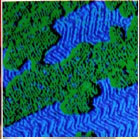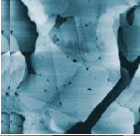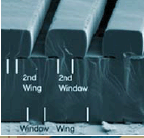Refine search
Actions for selected content:
106069 results in Materials Science
Niobium and tantalum doped titania particles
-
- Journal:
- Journal of Materials Research / Volume 25 / Issue 10 / October 2010
- Published online by Cambridge University Press:
- 31 January 2011, pp. 2015-2024
- Print publication:
- October 2010
-
- Article
- Export citation
Energy Innovation Hubs to address materials needs
-
- Journal:
- MRS Bulletin / Volume 35 / Issue 10 / October 2010
- Published online by Cambridge University Press:
- 31 January 2011, pp. 738-739
- Print publication:
- October 2010
-
- Article
-
- You have access
- Export citation
Electrodeposition and chemical bath deposition of functional nanomaterials
-
- Journal:
- MRS Bulletin / Volume 35 / Issue 10 / October 2010
- Published online by Cambridge University Press:
- 12 September 2016, pp. 743-750
- Print publication:
- October 2010
-
- Article
- Export citation
Electrodeposited magnetic layers in the ultrathin limit
-
- Journal:
- MRS Bulletin / Volume 35 / Issue 10 / October 2010
- Published online by Cambridge University Press:
- 31 January 2011, pp. 761-770
- Print publication:
- October 2010
-
- Article
- Export citation
Chemical epitaxy of semiconductor thin films
-
- Journal:
- MRS Bulletin / Volume 35 / Issue 10 / October 2010
- Published online by Cambridge University Press:
- 31 January 2011, pp. 790-796
- Print publication:
- October 2010
-
- Article
- Export citation
5 - Computer modeling of granular rheology
-
-
- Book:
- Experimental and Computational Techniques in Soft Condensed Matter Physics
- Published online:
- 05 July 2014
- Print publication:
- 02 September 2010, pp 121-146
-
- Chapter
- Export citation
1 - Some basic notions of classical and quantum statistical physics
-
- Book:
- Basic Aspects of the Quantum Theory of Solids
- Published online:
- 05 June 2012
- Print publication:
- 02 September 2010, pp 1-5
-
- Chapter
- Export citation
13 - Magnetic impurities in metals, Kondo effect, heavy fermions and mixed valence
-
- Book:
- Basic Aspects of the Quantum Theory of Solids
- Published online:
- 05 June 2012
- Print publication:
- 02 September 2010, pp 272-295
-
- Chapter
- Export citation
5 - General Bose systems; Bose condensation
-
- Book:
- Basic Aspects of the Quantum Theory of Solids
- Published online:
- 05 June 2012
- Print publication:
- 02 September 2010, pp 54-69
-
- Chapter
- Export citation
Index
-
- Book:
- Basic Aspects of the Quantum Theory of Solids
- Published online:
- 05 June 2012
- Print publication:
- 02 September 2010, pp 298-301
-
- Chapter
- Export citation
11 - Instabilities and phase transitions in electronic systems
-
- Book:
- Basic Aspects of the Quantum Theory of Solids
- Published online:
- 05 June 2012
- Print publication:
- 02 September 2010, pp 188-228
-
- Chapter
- Export citation
6 - Magnetism
-
- Book:
- Basic Aspects of the Quantum Theory of Solids
- Published online:
- 05 June 2012
- Print publication:
- 02 September 2010, pp 70-126
-
- Chapter
- Export citation
Foreword and general introduction
-
- Book:
- Basic Aspects of the Quantum Theory of Solids
- Published online:
- 05 June 2012
- Print publication:
- 02 September 2010, pp ix-xiv
-
- Chapter
- Export citation
2 - General theory of phase transitions
-
- Book:
- Basic Aspects of the Quantum Theory of Solids
- Published online:
- 05 June 2012
- Print publication:
- 02 September 2010, pp 6-30
-
- Chapter
- Export citation
8 - Interacting electrons. Green functions and Feynman diagrams (methods of field theory in many-particle physics)
-
- Book:
- Basic Aspects of the Quantum Theory of Solids
- Published online:
- 05 June 2012
- Print publication:
- 02 September 2010, pp 133-158
-
- Chapter
- Export citation
3 - Bose and Fermi statistics
-
- Book:
- Basic Aspects of the Quantum Theory of Solids
- Published online:
- 05 June 2012
- Print publication:
- 02 September 2010, pp 31-33
-
- Chapter
- Export citation
8 - Cellular automata models of granular flow
-
-
- Book:
- Experimental and Computational Techniques in Soft Condensed Matter Physics
- Published online:
- 05 July 2014
- Print publication:
- 02 September 2010, pp 209-229
-
- Chapter
- Export citation
10 - Fermi-liquid theory and its possible generalizations
-
- Book:
- Basic Aspects of the Quantum Theory of Solids
- Published online:
- 05 June 2012
- Print publication:
- 02 September 2010, pp 175-187
-
- Chapter
- Export citation
4 - Phonons in crystals
-
- Book:
- Basic Aspects of the Quantum Theory of Solids
- Published online:
- 05 June 2012
- Print publication:
- 02 September 2010, pp 34-53
-
- Chapter
- Export citation
Contributors
-
- Book:
- Experimental and Computational Techniques in Soft Condensed Matter Physics
- Published online:
- 05 July 2014
- Print publication:
- 02 September 2010, pp viii-x
-
- Chapter
- Export citation



